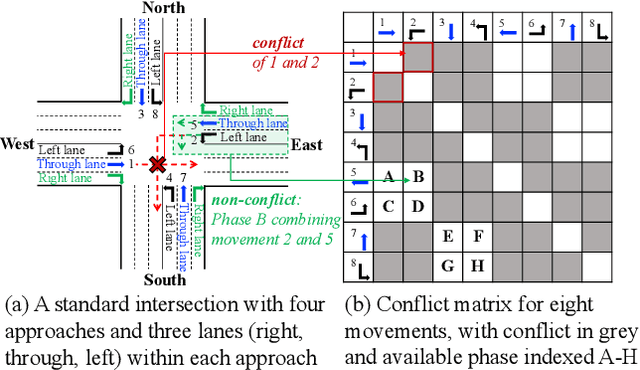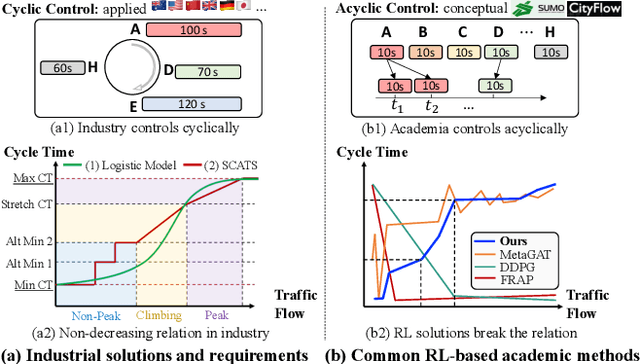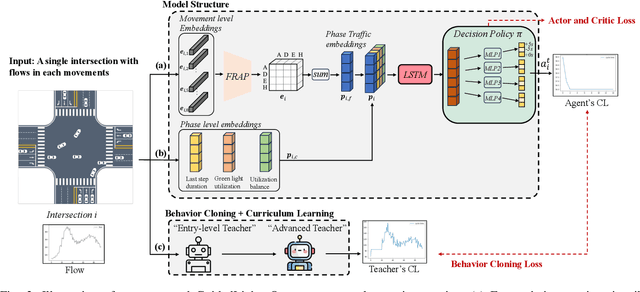Jingqing Ruan
Reasoner for Real-World Event Detection: Scaling Reinforcement Learning via Adaptive Perplexity-Aware Sampling Strategy
Jul 02, 2025Abstract:Detecting abnormal events in real-world customer service dialogues is highly challenging due to the complexity of business data and the dynamic nature of customer interactions. Moreover, models must demonstrate strong out-of-domain (OOD) generalization to enable rapid adaptation across different business scenarios and maximize commercial value. In this work, we propose a novel Adaptive Perplexity-Aware Reinforcement Learning (APARL) framework that leverages the advanced reasoning capabilities of large language models for abnormal event detection. APARL introduces a dual-loop dynamic curriculum learning architecture, enabling the model to progressively focus on more challenging samples as its proficiency increases. This design effectively addresses performance bottlenecks and significantly enhances OOD transferability. Extensive evaluations on food delivery dialogue tasks show that our model achieves significantly enhanced adaptability and robustness, attaining the highest F1 score with an average improvement of 17.19\%, and an average improvement of 9.59\% in OOD transfer tests. This method provides a superior solution for industrial deployment of anomaly detection models, contributing to improved operational efficiency and commercial benefits.
AMoPO: Adaptive Multi-objective Preference Optimization without Reward Models and Reference Models
Jun 08, 2025Abstract:Existing multi-objective preference alignment methods for large language models (LLMs) face limitations: (1) the inability to effectively balance various preference dimensions, and (2) reliance on auxiliary reward/reference models introduces computational complexity. To address these challenges, we propose Adaptive Multi-objective Preference Optimization (AMoPO), a novel framework that achieves dynamic balance across preference dimensions. By introducing the multi-objective optimization paradigm to use the dimension-aware generation metrics as implicit rewards, AMoPO aligns LLMs with diverse preferences without additional reward models or reference models. We introduce an adaptive weight assignment mechanism that models the generation space as a Gaussian distribution, allowing dynamic prioritization of preference dimensions. Empirical results demonstrate that AMoPO outperforms state-of-the-art baselines by 28.5%, and the experiments on 7B, 14B, and 32B models reveal the scaling ability of AMoPO. Moreover, additional analysis of multiple dimensions verifies its adaptability and effectiveness. These findings validate AMoPO's capability to achieve dimension-aware preference alignment, highlighting its superiority. Our codes and datasets are available at https://github.com/Javkonline/AMoPO.
When to Continue Thinking: Adaptive Thinking Mode Switching for Efficient Reasoning
May 21, 2025Abstract:Large reasoning models (LRMs) achieve remarkable performance via long reasoning chains, but often incur excessive computational overhead due to redundant reasoning, especially on simple tasks. In this work, we systematically quantify the upper bounds of LRMs under both Long-Thinking and No-Thinking modes, and uncover the phenomenon of "Internal Self-Recovery Mechanism" where models implicitly supplement reasoning during answer generation. Building on this insight, we propose Adaptive Self-Recovery Reasoning (ASRR), a framework that suppresses unnecessary reasoning and enables implicit recovery. By introducing accuracy-aware length reward regulation, ASRR adaptively allocates reasoning effort according to problem difficulty, achieving high efficiency with negligible performance sacrifice. Experiments across multiple benchmarks and models show that, compared with GRPO, ASRR reduces reasoning budget by up to 32.5% (1.5B) and 25.7% (7B) with minimal accuracy loss (1.2% and 0.6% pass@1), and significantly boosts harmless rates on safety benchmarks (up to +21.7%). Our results highlight the potential of ASRR for enabling efficient, adaptive, and safer reasoning in LRMs.
QPO: Query-dependent Prompt Optimization via Multi-Loop Offline Reinforcement Learning
Aug 20, 2024Abstract:Prompt engineering has demonstrated remarkable success in enhancing the performance of large language models (LLMs) across diverse tasks. However, most existing prompt optimization methods only focus on the task-level performance, overlooking the importance of query-preferred prompts, which leads to suboptimal performances. Additionally, these methods rely heavily on frequent interactions with LLMs to obtain feedback for guiding the optimization process, incurring substantial redundant interaction costs. In this paper, we introduce Query-dependent Prompt Optimization (QPO), which leverages multi-loop offline reinforcement learning to iteratively fine-tune a small pretrained language model to generate optimal prompts tailored to the input queries, thus significantly improving the prompting effect on the large target LLM. We derive insights from offline prompting demonstration data, which already exists in large quantities as a by-product of benchmarking diverse prompts on open-sourced tasks, thereby circumventing the expenses of online interactions. Furthermore, we continuously augment the offline dataset with the generated prompts in each loop, as the prompts from the fine-tuned model are supposed to outperform the source prompts in the original dataset. These iterative loops bootstrap the model towards generating optimal prompts. Experiments on various LLM scales and diverse NLP and math tasks demonstrate the efficacy and cost-efficiency of our method in both zero-shot and few-shot scenarios.
GuideLight: "Industrial Solution" Guidance for More Practical Traffic Signal Control Agents
Jul 15, 2024



Abstract:Currently, traffic signal control (TSC) methods based on reinforcement learning (RL) have proven superior to traditional methods. However, most RL methods face difficulties when applied in the real world due to three factors: input, output, and the cycle-flow relation. The industry's observable input is much more limited than simulation-based RL methods. For real-world solutions, only flow can be reliably collected, whereas common RL methods need more. For the output action, most RL methods focus on acyclic control, which real-world signal controllers do not support. Most importantly, industry standards require a consistent cycle-flow relationship: non-decreasing and different response strategies for low, medium, and high-level flows, which is ignored by the RL methods. To narrow the gap between RL methods and industry standards, we innovatively propose to use industry solutions to guide the RL agent. Specifically, we design behavior cloning and curriculum learning to guide the agent to mimic and meet industry requirements and, at the same time, leverage the power of exploration and exploitation in RL for better performance. We theoretically prove that such guidance can largely decrease the sample complexity to polynomials in the horizon when searching for an optimal policy. Our rigid experiments show that our method has good cycle-flow relation and superior performance.
CoSLight: Co-optimizing Collaborator Selection and Decision-making to Enhance Traffic Signal Control
May 27, 2024Abstract:Effective multi-intersection collaboration is pivotal for reinforcement-learning-based traffic signal control to alleviate congestion. Existing work mainly chooses neighboring intersections as collaborators. However, quite an amount of congestion, even some wide-range congestion, is caused by non-neighbors failing to collaborate. To address these issues, we propose to separate the collaborator selection as a second policy to be learned, concurrently being updated with the original signal-controlling policy. Specifically, the selection policy in real-time adaptively selects the best teammates according to phase- and intersection-level features. Empirical results on both synthetic and real-world datasets provide robust validation for the superiority of our approach, offering significant improvements over existing state-of-the-art methods. The code is available at https://github.com/AnonymousAccountss/CoSLight.
Hummer: Towards Limited Competitive Preference Dataset
May 21, 2024Abstract:Preference datasets are essential for incorporating human preferences into pre-trained language models, playing a key role in the success of Reinforcement Learning from Human Feedback. However, these datasets often demonstrate conflicting alignment objectives, leading to increased vulnerability to jailbreak attacks and challenges in adapting downstream tasks to prioritize specific alignment objectives without negatively impacting others. In this work, we introduce a novel statistical metric, Alignment Dimension Conflict, to quantify the degree of conflict within preference datasets. We then present \texttt{Hummer} and its fine-grained variant, \texttt{Hummer-F}, as innovative pairwise preference datasets with reduced-conflict alignment objectives. \texttt{Hummer} is built based on UltraFeedback and is enhanced by AI feedback from GPT-4, marking as the first preference dataset aimed at reducing the competition between alignment objectives. Furthermore, we develop reward models, HummerRM and HummerRM-F, which employ a hybrid sampling approach to balance diverse alignment objectives effectively. This sampling method positions HummerRM as an ideal model for domain-specific further fine-tuning and reducing vulnerabilities to attacks.
Learning Causal Dynamics Models in Object-Oriented Environments
May 21, 2024



Abstract:Causal dynamics models (CDMs) have demonstrated significant potential in addressing various challenges in reinforcement learning. To learn CDMs, recent studies have performed causal discovery to capture the causal dependencies among environmental variables. However, the learning of CDMs is still confined to small-scale environments due to computational complexity and sample efficiency constraints. This paper aims to extend CDMs to large-scale object-oriented environments, which consist of a multitude of objects classified into different categories. We introduce the Object-Oriented CDM (OOCDM) that shares causalities and parameters among objects belonging to the same class. Furthermore, we propose a learning method for OOCDM that enables it to adapt to a varying number of objects. Experiments on large-scale tasks indicate that OOCDM outperforms existing CDMs in terms of causal discovery, prediction accuracy, generalization, and computational efficiency.
X-Light: Cross-City Traffic Signal Control Using Transformer on Transformer as Meta Multi-Agent Reinforcement Learner
Apr 18, 2024



Abstract:The effectiveness of traffic light control has been significantly improved by current reinforcement learning-based approaches via better cooperation among multiple traffic lights. However, a persisting issue remains: how to obtain a multi-agent traffic signal control algorithm with remarkable transferability across diverse cities? In this paper, we propose a Transformer on Transformer (TonT) model for cross-city meta multi-agent traffic signal control, named as X-Light: We input the full Markov Decision Process trajectories, and the Lower Transformer aggregates the states, actions, rewards among the target intersection and its neighbors within a city, and the Upper Transformer learns the general decision trajectories across different cities. This dual-level approach bolsters the model's robust generalization and transferability. Notably, when directly transferring to unseen scenarios, ours surpasses all baseline methods with +7.91% on average, and even +16.3% in some cases, yielding the best results.
DuaLight: Enhancing Traffic Signal Control by Leveraging Scenario-Specific and Scenario-Shared Knowledge
Dec 22, 2023Abstract:Reinforcement learning has been revolutionizing the traditional traffic signal control task, showing promising power to relieve congestion and improve efficiency. However, the existing methods lack effective learning mechanisms capable of absorbing dynamic information inherent to a specific scenario and universally applicable dynamic information across various scenarios. Moreover, within each specific scenario, they fail to fully capture the essential empirical experiences about how to coordinate between neighboring and target intersections, leading to sub-optimal system-wide outcomes. Viewing these issues, we propose DuaLight, which aims to leverage both the experiential information within a single scenario and the generalizable information across various scenarios for enhanced decision-making. Specifically, DuaLight introduces a scenario-specific experiential weight module with two learnable parts: Intersection-wise and Feature-wise, guiding how to adaptively utilize neighbors and input features for each scenario, thus providing a more fine-grained understanding of different intersections. Furthermore, we implement a scenario-shared Co-Train module to facilitate the learning of generalizable dynamics information across different scenarios. Empirical results on both real-world and synthetic scenarios show DuaLight achieves competitive performance across various metrics, offering a promising solution to alleviate traffic congestion, with 3-7\% improvements. The code is available under: https://github.com/lujiaming-12138/DuaLight.
 Add to Chrome
Add to Chrome Add to Firefox
Add to Firefox Add to Edge
Add to Edge